|
 Armillaria limonea Armillaria limonea
SynonymsArmillariella limonea
Agaricus melleus
Armillaria mellea
Armillariella mellea
BiostatusPresent in region - Indigenous. Endemic
Images (click to enlarge)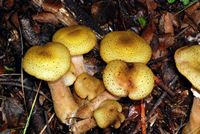
Owner: J.A. Cooper | 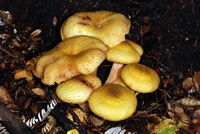
Owner: J.A. Cooper | 
Owner: J.A. Cooper | 
Owner: J.A. Cooper | 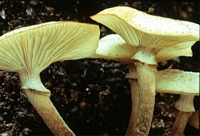
Owner: Herb. PDD | 
Caption: Armillaria limonea
Owner: Kaimai Bush | 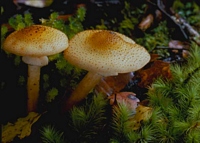
Owner: George Barron | 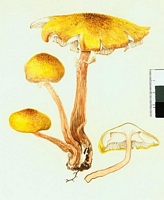
Caption: Watercolour
Owner: G.M. Taylor | 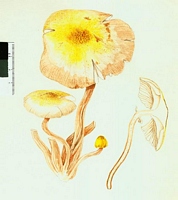
Caption: Watercolour
Owner: G.M. Taylor | 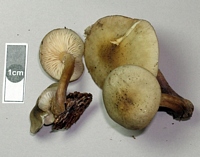
Owner: J.A. Cooper | 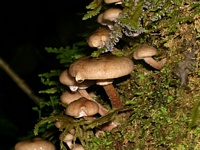
Owner: J.A. Cooper | 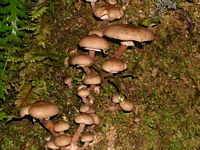
Owner: J.A. Cooper | 
Caption: Watercolour
Owner: G.M. Taylor | 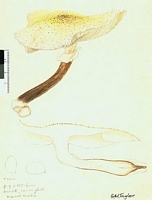
Caption: Watercolour
Owner: G.M. Taylor | 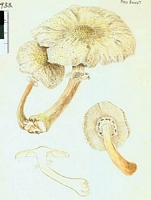
Caption: watercolour
Owner: G.M. Taylor | 
Caption: Fig. 25 | |
Notes: A. limonea is larger than A. novae-zelandiae, the cap yellowish in colour, with well-developed darker scales.
Article: Gadgil, P.D. (in association with Dick, M.A.; Hood, I.A.; Pennycook, S.R.) (2005). Fungi on trees and shrubs in New Zealand. Fungi of New Zealand. Ngā Harore o Aotearoa 4: xi + 437 p. Hong Kong: Fungal Diversity Press.
Description: Type: Radicicolous Fungi; Description: Basidiomata pileate, centrally stipitate. Pileus 80–130 mm in diameter, lemon yellow, with dark brown tufted scales sprinkled thickly at centre and more sparsely towards the margin, convex at first, becoming almost plane later, dry; flesh firm, white. Gills sinuately decurrent, moderately crowded, creamy white, becoming pinkish fawn. Stipe tapering towards the pileus, with a bulbous base, light brown above a substantial floccose annulus, shading to brown or olive green below, velutinate, solid, 100–150 mm long. Basidiospores ovoid, 7–8 × 5–7 m, non-amyloid; spore print white.
Distribution: Distribution: See Significance.; 1st Record: Stevenson (1964: as Armillariella limonea).
Article: Stevenson, G. (1964). The Agaricales of New Zealand: V. Kew Bulletin 19(1): 1-59.
Description: Pileus 8-13 cm diam., lemon yellow, sprinkled thickly at centre and more sparsely towards the margin with dark brown, tufted scales, dry, convex at first with strongly down-rolled margin, becoming almost plane with a waved edge; flesh firm, white. Gills sinuately decurrent, moderately crowded, creamy white becoming stained pinkish fawn. Stipe 10-15 x 1-1.5 cm, light brown above substantial floccose ring, shading to brown or olive green below, velutinate, sometimes with a few tufted scales, solid, tough, slightly bulbous at base. Spores 7-8 x 5-6.5 µm, non-amyloid, moderately thick-walled (Fig. 25); print white.
Habitat: In dense groups round standing dead Nothofagus, Butterfly, Wellington, 22.5.1949. Stevenson (type); Nelson, 6.6.1955, E. Cannington; Eve's Valley, Nelson, 10.5.1957, Stevenson.
Article: Stevenson, G. (1964). The Agaricales of New Zealand: V. Kew Bulletin 19(1): 1-59.
Description: This common tree-destroying fungus with very characteristic bootlace rhizomorphs is regularly seen in plantations. In Japan it is recognized as the mycorrhizal fungus of the saprophytic orchid Gastrodia R. Br., one species of which is fairly common throughout New Zealand.
|